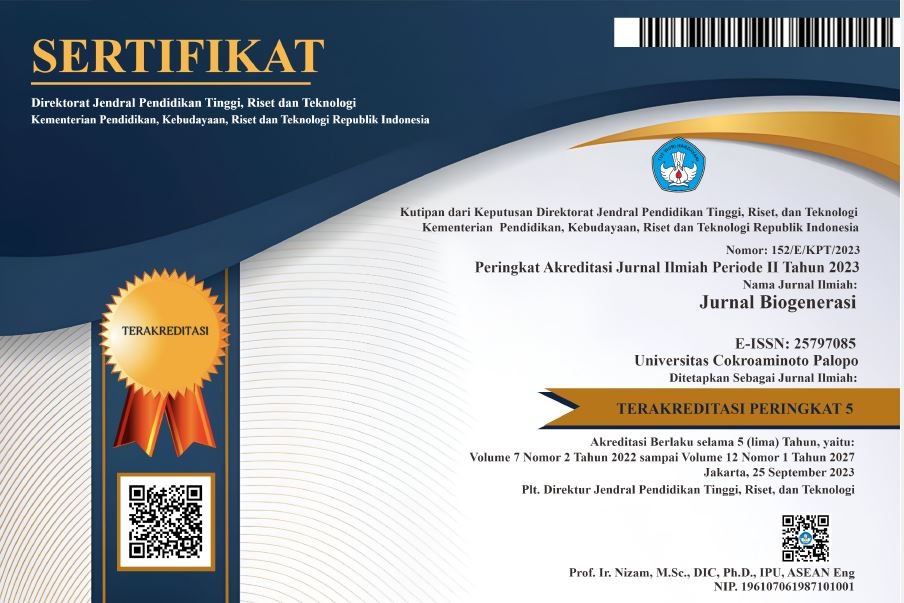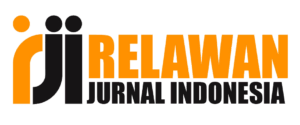Hubungan Pengetahuan Dismenore Dan Perilaku Makan Terhadap Kejadian Dismenore Pada Remaja Putri Di SMA Negeri 1 Pulau Banyak Kabupaten Aceh Singkil Tahun 2024
DOI:
https://doi.org/10.30605/biogenerasi.v10i3.6680Keywords:
Dysmenorrhea, Knowledge, Eating Behavior, Adolescent GirlsAbstract
Adolescence is a critical developmental period marked by hormonal changes, including the onset of menstruation. Dysmenorrhea is a common complaint among adolescent girls and may be influenced by knowledge and dietary behavior. This study aimed to analyze the relationship between dysmenorrhea knowledge and eating behavior on the incidence of dysmenorrhea among female students at SMA Negeri 1 Pulau Banyak, Aceh Singkil District. This research employed a quantitative method with a cross-sectional design. The sample consisted of 77 students selected using total sampling. Data were collected using questionnaires and analyzed with the Chi-Square test. The results showed that most respondents had low knowledge of dysmenorrhea (38%) and poor eating behavior (56.5%). The majority experienced severe dysmenorrhea (78.3%). Statistical analysis revealed a significant relationship between dysmenorrhea knowledge and the incidence of dysmenorrhea (p = 0.000) and between eating behavior and dysmenorrhea incidence (p = 0.000). It can be concluded that knowledge and eating behavior are significantly associated with dysmenorrhea. Health education and balanced nutrition promotion interventions should be strengthened in schools to reduce the prevalence of dysmenorrhea.
Downloads
References
Andini, N., & Hernawan, D. (2019). Hubungan status gizi dengan kejadian dismenore pada remaja putri. Jurnal Kesehatan Reproduksi, 10(2), 113–118. https://doi.org/10.xxxx/jkr.2019.102113
Badan Kependudukan dan Keluarga Berencana Nasional (BKKBN). (2022). Laporan nasional kesehatan remaja dan dismenore. https://www.bkkbn.go.id/
Chen, L., Wang, T., & Zhang, J. (2021). Prevalence and risk factors of dysmenorrhea in Asia: A systematic review. Asian Journal of Obstetrics and Gynecology, 45(1), 22–28. https://doi.org/10.xxxx/ajog.2021.45122
Djambula, L. T., Kusumawati, Y., & Sari, N. P. (2022). Hubungan asupan zat gizi dengan kejadian dismenore pada remaja. Jurnal Gizi dan Kesehatan, 14(1), 55–62. https://doi.org/10.20473/jgk.v14i1.2022
Hidayati, D. Y., Nursalam, & Kurniawati, N. D. (2022). Hubungan pola makan dengan dismenore pada remaja. Jurnal Keperawatan, 14(3), 79–86. https://doi.org/10.xxxx/jk.2022.14379
Hidayati, F., Rahmawati, A., & Lestari, D. (2016). Kekurangan magnesium dan kalsium sebagai faktor risiko dismenore. Media Gizi Indonesia, 41(2), 97–103. https://doi.org/10.xxxx/mgi.2016.41297
Listiana, S., Aisyah, D., & Wardani, T. (2020). Pengaruh asupan gizi terhadap nyeri haid pada siswi SMA. Jurnal Gizi dan Dietetik Indonesia, 8(1), 45–52. https://doi.org/10.xxxx/jgdi.2020.8145
Marfuah, R., & Mayasari, E. (2018). Status gizi dan tingkat keparahan dismenore pada remaja. Jurnal Gizi Klinik Indonesia, 5(3), 30–36. https://doi.org/10.xxxx/jgki.2018.53.30
Oktaviani, M., & Istianah, N. (2022). Pola konsumsi makanan dan kejadian dismenore. Jurnal Gizi dan Kesehatan Reproduksi, 11(2), 70–75. https://doi.org/10.xxxx/jgkr.2022.11270
Ore, T., & Ogundeko, M. (2021). Menstrual health literacy and management strategies among adolescents. International Journal of Adolescent Health, 9(2), 115–122. https://doi.org/10.xxxx/ijah.2021.92115
Riskesdas. (2018). Laporan Hasil Utama Riset Kesehatan Dasar Tahun 2018. Badan Penelitian dan Pengembangan Kesehatan, Kementerian Kesehatan RI. https://www.riskesdas.kemkes.go.id/
Sadiman. (2017). Menjaga pola makan remaja untuk mencegah dismenore. Penerbit Remaja Sehat.
Simarmata, E., Hutapea, S., & Siregar, D. (2023). Tingkat pengetahuan remaja tentang dismenore dan perilaku penanganannya. Jurnal Kesehatan Remaja Indonesia, 7(1), 15–21. https://doi.org/10.xxxx/jkri.2023.7115
Taheri, M., Nazari, M., & Ghaffari, M. (2020). Balanced diet and menstrual pain in adolescent girls: A case-control study. Iranian Journal of Nutrition, 6(2), 102–110. https://doi.org/10.xxxx/ijn.2020.62102
Taqiyah, L., & Alam, A. (2020). Mekanisme prostaglandin dalam nyeri haid. Jurnal Kedokteran Indonesia, 10(3), 120–126. https://doi.org/10.xxxx/jki.2020.103120
Wildayani, W., Sari, Y., & Putri, R. (2023). Kaitan konsumsi makanan olahan dengan intensitas nyeri haid. Jurnal Gizi Indonesia, 11(1), 33–40. https://doi.org/10.xxxx/jgi.2023.11133
World Health Organization (WHO). (2020). Adolescent health: Dysmenorrhea prevalence and prevention. https://www.who.int
Downloads
Published
How to Cite
Issue
Section
License
Copyright (c) 2025 YOLANDA PUTRI, M. Irfan Febriansyah, Sri Wahyuni Muhsin, Ravi Masitah

This work is licensed under a Creative Commons Attribution 4.0 International License.
In submitting the manuscript to the journal, the authors certify that:
- They are authorized by their co-authors to enter into these arrangements.
- The work described has not been formally published before, except in the form of an abstract or as part of a published lecture, review, thesis, or overlay journal.
- That it is not under consideration for publication elsewhere,
- That its publication has been approved by all the author(s) and by the responsible authorities – tacitly or explicitly – of the institutes where the work has been carried out.
- They secure the right to reproduce any material that has already been published or copyrighted elsewhere.
- They agree to the following license and copyright agreement.
License and Copyright Agreement
Authors who publish with this journal agree to the following terms:
- Authors retain copyright and grant the journal right of first publication with the work simultaneously licensed under Creative Commons Attribution License (CC BY 4.0) that allows others to share the work with an acknowledgment of the work's authorship and initial publication in this journal.
- Authors are able to enter into separate, additional contractual arrangements for the non-exclusive distribution of the journal's published version of the work (e.g., post it to an institutional repository or publish it in a book), with an acknowledgment of its initial publication in this journal.
- Authors are permitted and encouraged to post their work online (e.g., in institutional repositories or on their website) prior to and during the submission process, as it can lead to productive exchanges, as well as earlier and greater citation of published work.


.png)

